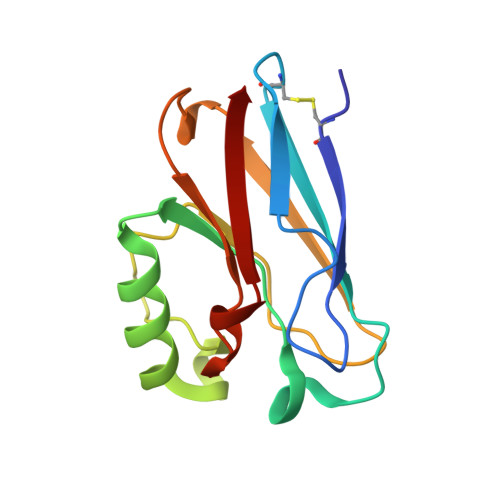Copper-sulfenate complex from oxidation of a cavity mutant of Pseudomonas aeruginosa azurin.
Sieracki, N.A., Tian, S., Hadt, R.G., Zhang, J.L., Woertink, J.S., Nilges, M.J., Sun, F., Solomon, E.I., Lu, Y.(2014) Proc Natl Acad Sci U S A 111: 924-929
- PubMed: 24390543
- DOI: https://doi.org/10.1073/pnas.1316483111
- Primary Citation of Related Structures:
4MFH - PubMed Abstract:
Metal-sulfenate centers are known to play important roles in biology and yet only limited examples are known due to their instability and high reactivity. Herein we report a copper-sulfenate complex characterized in a protein environment, formed at the active site of a cavity mutant of an electron transfer protein, type 1 blue copper azurin. Reaction of hydrogen peroxide with Cu(I)-M121G azurin resulted in a species with strong visible absorptions at 350 and 452 nm and a relatively low electron paramagnetic resonance gz value of 2.169 in comparison with other normal type 2 copper centers. The presence of a side-on copper-sulfenate species is supported by resonance Raman spectroscopy, electrospray mass spectrometry using isotopically enriched hydrogen peroxide, and density functional theory calculations correlated to the experimental data. In contrast, the reaction with Cu(II)-M121G or Zn(II)-M121G azurin under the same conditions did not result in Cys oxidation or copper-sulfenate formation. Structural and computational studies strongly suggest that the secondary coordination sphere noncovalent interactions are critical in stabilizing this highly reactive species, which can further react with oxygen to form a sulfinate and then a sulfonate species, as demonstrated by mass spectrometry. Engineering the electron transfer protein azurin into an active copper enzyme that forms a copper-sulfenate center and demonstrating the importance of noncovalent secondary sphere interactions in stabilizing it constitute important contributions toward the understanding of metal-sulfenate species in biological systems.
Organizational Affiliation:
Department of Chemistry, University of Illinois at Urbana-Champaign, Urbana, IL 61801.
















